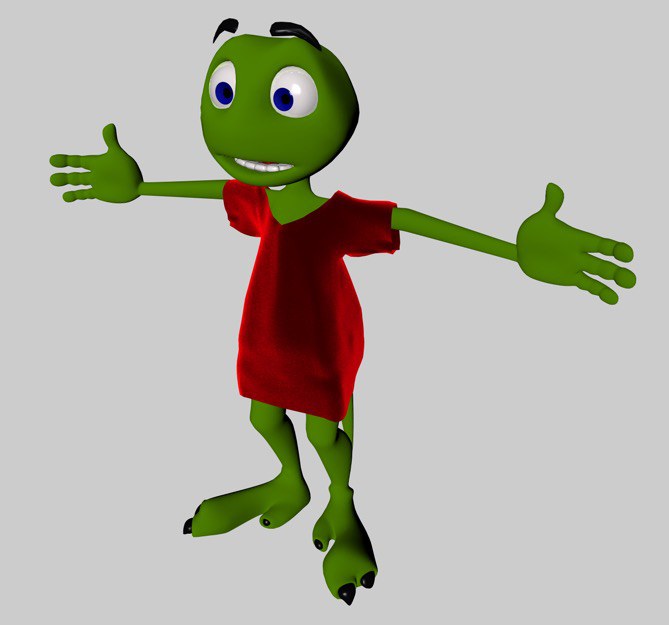 Cloth Surface 布面Basic 基础Coord.Object 对象
Cloth Surface 布面Basic 基础Coord.Object 对象
Object Properties
对象属性
细分[0. . 7]
This field is very similar to the Subdivision settings located in the Subdivision Surface object. A value of 1 will subdivide each polygon of the child object into four smaller polygons, a value of 2 will subdivide each polygon of the child object into sixteen smaller polygons and so on. The subdivision value will control how smooth the Cloth Simulation object appears to be. The higher the number, the slower the playback will be during the cloth simulation, but the nicer the results.
这个字段非常类似于位于细分曲面对象中的 subcite 设置。值1将子对象的每个多边形细分为4个较小的多边形,值2将子对象的每个多边形细分为十六个较小的多边形,以此类推。细分值将控制布料仿真对象的光滑程度。数值越大,在布料模拟过程中播放速度越慢,但效果越好。

The images above show the original polygonal cage that has the Cloth tag applied to it (left) and the same polygonal cage with a Cloth object applied to it using a Subdivision value of 2. The wrinkles and bulges of the cloth become more defined as the subdivision increases.
上面的图片显示的是原来的多边形笼子,上面贴着布标签(左) ,同样的多边形笼子,上面贴着布对象,细分值为2。随着细分的增加,织物的皱褶和凸起变得更加明显。
 Tip
小贴士
Tip
小贴士因素[0. . 100% ]
This setting will interpolate the surface Normals of the polygonal cage, or more accurately the cloth object. A value of 0% means that the subdivided surface will not interpolate the surface Normals. A value of 100% will interpolate the surface Normals when subdividing the surface.
此设置将插值多边形笼子的表面法线,或者更准确地插值布料对象。如果值为0% ,则表示被细分的曲面不会插值曲面法线。当细分曲面时,一个100% 的值将插值曲面法线。

Above is an example of how the surface Normals are interpolated as the Factor value is increased on the same object.
上面是一个例子,表面法线是如何插值的因素值是增加对同一对象。
限制
At many times during a cloth simulation, two points may approach each other whose corresponding surface Normals are adjacent to each other. At this point the Cloth surface will interpolate its subdivided surface through the control cage or cloth object. The Limit option will prevent this from happening. Take the given situation:
在布料模拟的许多时候,两个点可能彼此接近,其相应的表面法线彼此相邻。此时,布料表面将通过控制笼或布料对象插值其细分表面。限制选项将防止这种情况发生。以给定的情况为例:
With the Limit option disabled the subdivided surface will pass through the control cage.
随着限制选项禁用细分表面将通过控制笼。

With the Limit option enabled the subdivided surface will not pass through the control cage’s surface. The direction of the surface Normals for the polygonal cage will determine if the Cloth surface is passing through the geometry.
有了极限选项启用的细分表面将不会通过控制笼的表面。多边形保持架表面法线的方向将决定布料表面是否通过几何形状。
厚度[-∞ . . + ∞ m ]
This is another property that separates Cloth surface from the Subdivision Surface object. By increasing the Thickness setting, the Cloth surface object will generate a form of extrusion to make the cloth look thick. The thickness of the subdivided surface will be determined by the direction of the surface Normals for the control cage. This allows for the control cage to be modeled without thickness resulting in fewer polygons that need to be calculated during the cloth simulation.
这是另一个将布料表面和细分曲面物体分开的属性。通过增加厚度设置,布料表面物体将产生一种挤出的形式,使布料看起来厚。细分表面的厚度将由控制笼的表面法线的方向决定。这允许控制笼没有厚度的建模导致在布料模拟期间需要计算的多边形更少。

The left image above shows the Cloth surface when using a Thickness value of 20. Also notice that the Normals are facing up the Y axis, which is defining the direction of the thickness.
上面左边的图片显示了使用厚度值为20的布料表面。还要注意,法线面向 y 轴,y 轴定义了厚度的方向。

The right image above shows another Cloth surface using the Thickness setting. As opposed to the other image, this one has the surface Normals reversed.
上面的右图显示了另一个使用厚度设置的布料表面。相对于另一张图片,这张图片的表面法线反转了。
膨胀
This option offers another possibility for creating thickness. The thickness is created dependent on the number of polygons belonging a point and their polygon normals (thickness and orientation will be added). This means that the thickness will abate towards the edges and increase towards the poles. Thicknesses greater than defined will be generated. This effect is often exaggerated one that diminishes towards the edges.
这个选项为创建厚度提供了另一种可能性。厚度是根据属于一个点的多边形数量和它们的多边形法线(厚度和方向将被添加)来创建的。这意味着厚度将减弱的边缘和增加向两极。产生的厚度大于定义的厚度。这种效果常常被夸大,而且往往边缘地减弱。